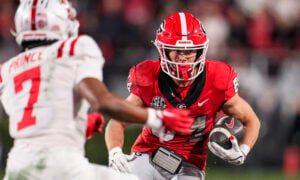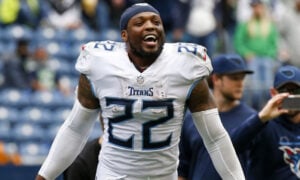Dynasty Capsule: New York Jets
Every year we give our premium content members a team-by-team, player-by-player look at the NFL season that was. The coverage will be in-depth, but because the Dynasty Capsule series begins immediately after the season, we won’t use it to discuss free agency or the draft. Come see us in early May once Mr. Irrelevant is off the board for another 32-article series giving you the same detailed discussion you’ll see below.
Buckle up dynasty fans, because you’re about to be reminded why our motto is, “There is no off-season.”
The New York Jets were supposed to be terrible in 2017, but they were fairly respectable. After off-loading nearly all of their big contracts in what was perceived as a not-so-subtle effort to tank, the Jets went 5-11 – not good, but not the laughing stock most were expecting.
Let’s take a look at how their fantasy-relevant players fared this past season.
Quarterback
JOSH MCCOWN
One of the biggest reasons the Jets weren’t awful was the play of McCown. A veteran journeyman, McCown put together the best full season of his career, completing 67.3 percent of his passes while throwing for 2,926 yards, 18 touchdowns and nine interceptions in 13 games. Those numbers translated to some pretty solid fantasy production as McCown finished as the QB16 going by points per game – ahead of the likes of Jameis Winston, Matt Ryan and Marcus Mariota. He wasn’t a low-ceiling option, either, as he had three weeks of at least 24 fantasy points, something Drew Brees and Ryan failed to do once.
He was more than good enough to start on an every-week basis in superflex leagues, but his future is uncertain. With the Jets expected to take a young quarterback in the 2018 Draft and McCown headed to free agency, the veteran may not have a starting job next fall. If he goes into the campaign as a starter somewhere, he’ll have some superflex value, although he may have a tough time repeating his 2017 output.
[am4show have=’g1;’ guest_error=’sub_message’ user_error=’sub_message’ ]
BRYCE PETTY
Petty got a three-start run at the end of the year, but it’s unlikely he did anything to prove to the Jets’ brass that he could be their starter going forward. Petty tossed one touchdown with three picks while completing a mere 49.1 percent of his 112 attempts. He’ll likely be back with Gang Green next year, but he’s set to be a free agent after 2018.
CHRISTIAN HACKENBERG
Hackenberg hasn’t done anything to shake the label of one of the worst second-round picks in recent memory. Last season marked his second straight year without appearing in a game, and even though the Jets insist the book isn’t closed on Hackenberg, he’s an extreme long shot to make a meaningful impact in his NFL career. His dead cap hit is less than $1 million for each of the next two years, so the Jets could sever ties this off-season.
Running Back
BILAL POWELL
Powell carried the mail in this backfield, logging 178 attempts with an additional 23 receptions. He finished with 772 rushing yards (4.3 YPC) and five touchdowns on the ground with 170 yards as a receiver. Powell came in as the RB26 in standard formats after checking in as the RB22 in 2016. He had just four weeks with double-digit standard-league points, but two of those weeks were 20-point efforts. Nothing about Powell is all that sexy, but he could see another solid workload in 2018, the final year of his contract, because the Jets’ running back depth chart isn’t exactly loaded. He’s currently the RB54, per our January ADP, two spots in front of this next guy.
ELIJAH MCGUIRE
A rookie sixth-round pick, McGuire flashed some big-play ability, but his season-long numbers leave a lot to be desired. McGuire ended the year with 88 carries for 315 yards and one score, adding 17 catches for 117 yards and another score in the passing game. He ripped off a 69-yard run in week four, but other than that play, he carried the ball 87 times for 246 yards – an ugly 2.83 yards per run. His value of RB56 is almost entirely tied to his chances of being the starting back for the Jets in 2018, something that could happen if New York opts to go with youth and play McGuire over Powell. Based on the numbers, Powell looks like the much better back right now, although it’s risky to take too much from a sample size of 88 rushing attempts.
MATT FORTE
Forte played in 12 games but took a backseat to Powell. He saw double-digit carries in just three games, although Forte did average exactly 10 attempts per game over his final six outings. He turned his 103 carries into 381 yards (3.7 YPC) and two scores, and he chipped in with 37 catches (on 45 targets) for 293 yards and a touchdown as a receiver. The Jets can cut him this spring with just $1 million in dead cap money while saving $3 million, and early reports have them doing just that. At this point in what’s been a sparkling career, Forte is unlikely to see the consistent week-to-week volume to be anything more than a bye-week dart throw in PPR formats regardless of where he lands.
Wide Receivers
ROBBY ANDERSON
Anderson broke out as a big-time playmaker in 2017, finishing as the WR16 in standard formats. His 137 standard-league points were more than Stefon Diggs, Mike Evans, JuJu Smith-Schuster, Golden Tate and Dez Bryant had – just to name a few notable wideouts. Anderson hauled in a meager 63 of his 114 targets, making a living running deep, high-variance routes. He finished with 941 yards and seven touchdowns, averaging 14.9 yards per grab. It was an impressive year no matter how you slice it.
His off-season hasn’t gone quite as well as Anderson has been making headlines for the wrong reasons. Still, it’s very unlikely the Jets cut him (based on what we know now), and he should be back in a high-volume role in 2018 despite a likely suspension. Anderson is currently the WR42, and he’s going into his age-25 campaign next fall.
JERMAINE KEARSE
Kearse’s fantasy stock benefitted from a trade to the Jets, who were more than happy to give him a steady role. Kearse set career-best marks in targets (102), catches (65) and yards (810) while tying a career high with five touchdowns. Despite the good year, there are a lot of variables at play with Kearse. He’ll need some player personnel moves to go his way to see 100-plus targets again in 2018; most notably, he’ll likely need the Jets to let this next player walk in restricted free agency.
QUINCY ENUNWA
Enunwa had a breakout of sorts in 2016, putting up a 58-857-4 line, but his 2017 campaign never got off the ground as neck surgery shelved him for the entire year. As we just mentioned, he’s a restricted free agent this off-season, and how his situation plays out will have a big impact on the Jets’ receiver depth chart (and possibly their draft plans). If Enunwa returns, his role will be up in the air, although if the Jets match an offer sheet for him, it’ll likely be because they have plans to make him a key part of their offense. If Enunwa walks, he’s unlikely to find a depth chart as soft as this one regardless of where he goes, so it may be best for his fantasy value if he stays in the Big Apple.
CHAD HANSEN
The Jets have some young wideouts who they probably want to throw into the fire, and these next three players – including Hansen – could see bigger roles going forward. A fourth-round pick in 2017, Hansen saw action in 15 games, spending most of his time on special teams. He ended the year with nine catches and 94 yards on 17 targets. While Hansen was primarily a special teamer, he did see considerably more snaps than either of the next two receivers on this list as he played at least 40 percent of the offensive snaps in each of New York’s final eight games. As it stands now, it appears Hansen has the inside track over the next two players when it comes to depth chart battles.
ARDARIUS STEWART
Stewart was taken in the third round in 2017, but as we just covered, he didn’t see as many snaps as Hansen did. He did play in 15 games, making six receptions for 82 yards while adding seven carries for 27 yards. Stewart is unlikely to make much of a fantasy impact in 2018.
CHARONE PEAKE
Taken in the seventh-round in 2016, Peake became something of a dynasty darling due to his size and athleticism. Through two years, he hasn’t done much on the field, and he saw action in just three games in 2017 before an ankle injury sent him to the injured reserve. He caught one pass for three yards in those three games after finishing 2016 with a 16-186-0 line.
Tight End
AUSTIN SEFERIAN-JENKINS
Seferian-Jenkins was a feel-good story for the Jets, overcoming his battles with alcohol, which ultimately got him cut by the Tampa Bay Buccaneers, to get his life on track and put together a productive season. ASJ hauled in 50 of his 74 targets for 357 yards and three touchdowns in 13 games. He had a touchdown in three straight games in October, and he saw at least five targets in eight of his 13 games. Still just 25, ASJ is headed to the open market and should garner a decent amount of interest as a free agent after taking a step in the right direction in 2017. With tight end so thin in fantasy outside of the elite options, it’s worth monitoring his situation. He’s currently the TE18, according to January ADP.
JORDAN LEGGETT
Leggett was snagged in the fifth round in 2017, and he did what most rookie tight ends do – nothing. Leggett didn’t play a single game as a rookie, and the reports last off-season that said he was coming along slowly couldn’t have been more correct. If Seferian-Jenkins leaves, Leggett could walk into a bigger role in 2018.
ERIC TOMLINSON
While the Jets would almost certainly bring in other tight ends via the draft or free agency if they don’t re-sign Seferian-Jenkins, Tomlinson is at least worth knowing in case the off-season dominoes fall his way. Tomlinson had eight catches for 121 yards and one score in 2017, his first season with any sort of receiving action. He’s an exclusive rights free agent.
[/am4show]
- Dynasty Capsule: Indianapolis Colts - January 17, 2019
- 2018 Summer Sleeper: Los Angeles Chargers - July 31, 2018
- Four Receivers to Sell this Off-Season - April 24, 2018


































































